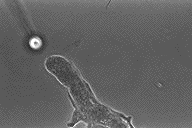Invertebrate
Zoology Amoeboid Protozoans
|
|
|
Amoeboid Protozoans
1.
Move
by means of pseudopodia
2.
Most are free-living and heterotrophic; a few are obligate parasites
3.
4. Body surrounded only by its own cell membrane, shape changes continuously
5.
|
